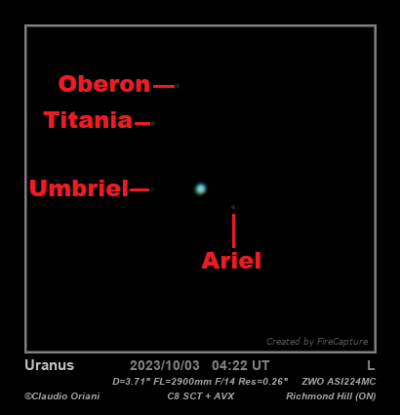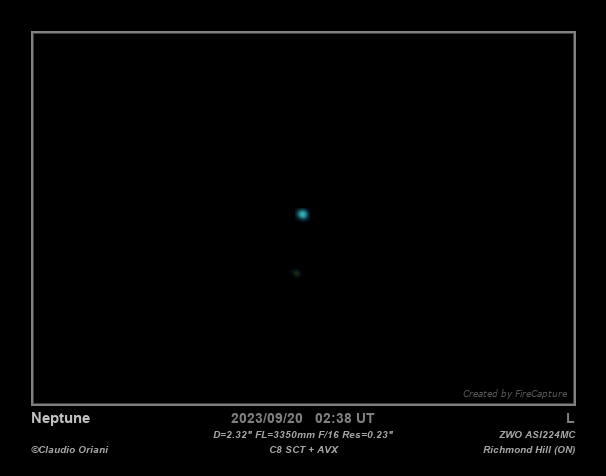I imaged the elusive ice giant planets: Uranus and Neptune
I imaged the elusive ice giant planets: Uranus and Neptune
2
Minutes
At the beginning of October 2023 I was out again for more planetary imaging. When I started my imaging session weather and seeing were not good and I was about to give up. But around midnight seeing and transparency dramatically improved. As a result, I was able to add Uranus and 4 of its moons to my 2023 collection!
Date: 2023-10-03 04:24 UT
Location: My driveway in Richmond Hill (ON)
Scope: Celestron 8 SCT
Mount: Celestron AVX
Camera: ZWO ASI224MC, ZWO ADC (atmospheric dispersion corrector)
Location: My driveway in Richmond Hill (ON)
Scope: Celestron 8 SCT
Mount: Celestron AVX
Camera: ZWO ASI224MC, ZWO ADC (atmospheric dispersion corrector)
Filter: ZWO IR Cut filter
Focuser: Celestron Focus Motor
Software: FireCapture (best 50% from a 180seconds video), AutoStakkert!3 (AS!3), Registax, Topaz DeNoise AI, GIMP.
Software: FireCapture (best 50% from a 180seconds video), AutoStakkert!3 (AS!3), Registax, Topaz DeNoise AI, GIMP.
Total # Frames:
Gain: 316
Shutter: 316 milliseconds
The final processed image of Uranus and 4 of its moons. You can scroll the slider to see the annotated image with the name of the moons.
In the image you can see Ariel (bottom of the image), Umbriel, Titania and Oberon. I wasn’t able to detect Miranda, probably because its magnitude (16.2) makes Miranda a challenging target for my scope.


Neptune was also in opposition on September 19. I couldn’t resist the opportunity to try and capture the elusive blue planet at its brightest through my telescope.
At a distance of 28.902 Astronomical Units, which is 4.323 million km, Neptune’s apparent diameter was just 2.36 arcseconds and its magnitude was 7.68. I was also able to spot its moon Triton, with a magnitude of 13.44 and a diameter of only 2705 km, just below Neptune.
I used FireCapture and the final image is a combination of 405 frames from a 60 seconds video.

